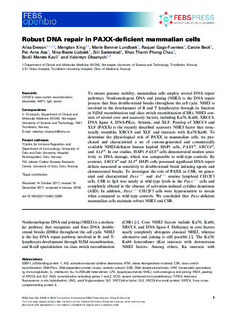Robust DNA repair in PAXX-deficient mammalian cells
| dc.contributor.author | Dewan, Alisa Elinsdatter | |
| dc.contributor.author | Xing, Mengtan | |
| dc.contributor.author | Lundbæk, Marie Benner | |
| dc.contributor.author | Gago-Fuentes, Raquel | |
| dc.contributor.author | Beck, Carole | |
| dc.contributor.author | Aas, Per Arne | |
| dc.contributor.author | Liabakk, Nina-Beate | |
| dc.contributor.author | Sæterstad, Siri | |
| dc.contributor.author | Khac Thanh Phong, Chau | |
| dc.contributor.author | Kavli, Bodil Merete | |
| dc.contributor.author | Oksenych, Valentyn | |
| dc.date.accessioned | 2018-02-23T12:48:25Z | |
| dc.date.available | 2018-02-23T12:48:25Z | |
| dc.date.created | 2018-01-22T15:01:47Z | |
| dc.date.issued | 2018 | |
| dc.identifier.issn | 2211-5463 | |
| dc.identifier.uri | http://hdl.handle.net/11250/2486767 | |
| dc.description.abstract | To ensure genome stability, mammalian cells employ several DNA repair pathways. Nonhomologous DNA end joining (NHEJ) is the DNA repair process that fixes double-strand breaks throughout the cell cycle. NHEJ is involved in the development of B and T lymphocytes through its function in V(D)J recombination and class switch recombination (CSR). NHEJ consists of several core and accessory factors, including Ku70, Ku80, XRCC4, DNA ligase 4, DNA-PKcs, Artemis, and XLF. Paralog of XRCC4 and XLF (PAXX) is the recently described accessory NHEJ factor that structurally resembles XRCC4 and XLF and interacts with Ku70/Ku80. To determine the physiological role of PAXX in mammalian cells, we purchased and characterized a set of custom-generated and commercially available NHEJ-deficient human haploid HAP1 cells, PAXXΔ, XRCC4Δ, and XLFΔ. In our studies, HAP1 PAXXΔ cells demonstrated modest sensitivity to DNA damage, which was comparable to wild-type controls. By contrast, XRCC4Δ and XLFΔ HAP1 cells possessed significant DNA repair defects measured as sensitivity to double-strand break inducing agents and chromosomal breaks. To investigate the role of PAXX in CSR, we generated and characterized Paxx−/− and Aid−/− murine lymphoid CH12F3 cells. CSR to IgA was nearly at wild-type levels in the Paxx−/− cells and completely ablated in the absence of activation-induced cytidine deaminase (AID). In addition, Paxx−/− CH12F3 cells were hypersensitive to zeocin when compared to wild-type controls. We concluded that Paxx-deficient mammalian cells maintain robust NHEJ and CSR. | nb_NO |
| dc.language.iso | eng | nb_NO |
| dc.publisher | Wiley Open Access | nb_NO |
| dc.rights | Navngivelse 4.0 Internasjonal | * |
| dc.rights.uri | http://creativecommons.org/licenses/by/4.0/deed.no | * |
| dc.title | Robust DNA repair in PAXX-deficient mammalian cells | nb_NO |
| dc.type | Journal article | nb_NO |
| dc.type | Peer reviewed | nb_NO |
| dc.description.version | publishedVersion | nb_NO |
| dc.source.journal | FEBS Open Bio | nb_NO |
| dc.identifier.doi | 10.1002/2211-5463.12380 | |
| dc.identifier.cristin | 1549343 | |
| dc.description.localcode | © 2018 The Authors. Published by FEBS Press and John Wiley & Sons Ltd. This is an open access article under the terms of the Creative Commons Attribution License, which permits use, distribution and reproduction in any medium, provided the original work is properly cited. | nb_NO |
| cristin.unitcode | 194,65,15,0 | |
| cristin.unitname | Institutt for klinisk og molekylær medisin | |
| cristin.ispublished | true | |
| cristin.fulltext | original | |
| cristin.qualitycode | 1 |

